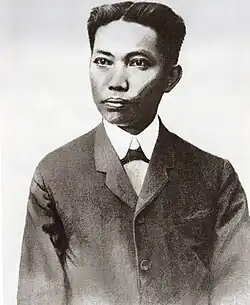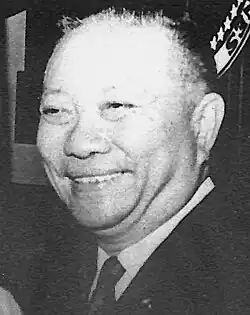López family of Iloilo
| López family of Iloilo | |
|---|---|
| Country | Philippines |
| Place of origin | Jaro, Iloilo City |
| Members | Basílio López Eugenio López Sr. Fernando López Eugenio López Jr. Eugenio López III Gina López Mark López Carlo López Katigbak |
The López family of Iloílo is a wealthy and influential Filipino family of business magnates, media proprietors, politicians, and philanthropists descended from Sangley Chinese Filipino merchant Basílio López (c. 1800–c. 1875), who adopted the surname of his Spanish master, López, upon the latter's death. He married Sabina Jalandoni and the couple had sixteen children:[1] Eulalia, Clara, Eulogia, Eugenio (1839–1906, "Kapitán Eugenio"), Gregoria, Estanislao, Marcelo, Claudio, Simón, Agripino, Francisco, Cipriana, Agripino, Eusebio, Ysidora, and María.[2]
The most prominent family members were the brothers Eugenio "Eñíng" H. López (1901–1975) and Fernando "Nandíng" H. López (1904–1993), great-grandsons of Basílio López and grandsons of Kapitán Eugenio J. López. The brothers' business interests are now known as the López Group of Companies. It includes the media and entertainment conglomerate ABS-CBN Corporation, and power generation and distribution company First Philippine Holdings Corporation.[3] Fernando also served twice as Vice President of the Philippines under Presidents Elpidio Quirino and Ferdinand Marcos
History
Sugar industry and financial loss
The Lopez family were once among the most prominent family of hacenderos in Iloilo during the early 1900s. Outside Iloilo, the Lopez family also owned numerous haciendas in Negros, first acquired by Eugenio Lopez (b. 1839) during the Spanish colonial period.[4] They were heavily engaged in the sugar milling industry and was an influential political family during the early American colonial period. To expand their sugar empire, the Lopezes made intermarriage between different native sugar centralists. For instance, Eusebio Lopez, who founded the Sagay Sugar Central, was married to the sister of Cesar Ledesma, Talisay Sugar Central's vice-president.[5]
However during the 1921 Philippine financial crisis, the Lopez family incurred losses due to them being borrowers of the loans given by the Philippine National Bank under PNB president Venancio Concepcion. Throughout the 1920s, the Lopez family tried to save their haciendas in Negros.[4][5] In 1927, the Lopez family gave their own assets to finance the Lopez Sugar Central located in northern Negros.[4] In 1928, the Philippines Free Press mocked the sugar situation in Negros by portraying a Negros woman inviting Batangas revolutionary leader Don Sixto Lopez just for him to be crippled with debt.[5]
Eugenio Lopez's business ventures
Despite inheriting the haciendas left by their father, the Lopez brothers, Eugenio and Fernando Lopez started humbly as bus operators in the 1930s. To improve the financial standing of his family, Eugenio Lopez started business ventures away from the sugar industry. He invested his money and resources in the transportation business such as the Iloilo Transportation Co., valued at P250,000 in 1937, and Panay Autobus, which he acquired in 1938 for P565,000.[4]
Eventually, Eugenio became a well-respected businessman. Due to the Lopez family becoming financially stable and wealthy, he started supporting his brother, Fernando, in his political pursuits. In 1947, he sold the Far Eastern Air Transport for P2.8 million. In 1951, he returned to the sugar milling business, much like his ancestors, by acquiring the Binalbagan-Isabela Sugar Milling Co. for P2.7 million.[4]
One significant move that changed the status of the Lopez family in the Philippines, from a disgraced family of sugar millers and bus operators to that of well-known financiers and business magnates, was Eugenio Lopez's purchase of the Meralco Security Corporation during the 1960s, which had a book value of more than P1 billion in June 1973.[4]
Notable members
-
![Eugenio Gabriel "Gabby" La'O Lopez III.[6][7]](./_assets_/Eugenio_Lopez%252C_III.jpg)
-
![Regina Paz "Gina" La'O Lopez[8]](./_assets_/Gina_Lopez_-_2017_(cropped).jpg) Regina Paz "Gina" La'O Lopez[8]
Regina Paz "Gina" La'O Lopez[8] -
.jpg) Ramon Lopez, a member of the Philippine Assembly
Ramon Lopez, a member of the Philippine Assembly -
 Benito Lopez, Governor of Iloilo
Benito Lopez, Governor of Iloilo -
 Fernando Lopez, vice president of the Philippines
Fernando Lopez, vice president of the Philippines
- Benito Villanueva López
- Fernando Hofileña López
- Eugenio Hofileña López, Sr.
- Eugenio Moreno López, Jr.
- Eugenio Gabriel La'O López III
- Gina La'O López
- Martin Lagdameo López
- Carlo López Katigbak
References
- ^ McCoy, Alfred (2009). An Anarchy of Families: State and Family in the Philippines (reprint ed.). University of Wisconsin Press. ISBN 9780299229849.
- ^ "The Lopez Family". philippines.mom-rsf.org. Retrieved December 7, 2021.
- ^ Brazil, Eric (July 2, 1999). "Eugenio Lopez, Philippine mogul, powerful patriarch helped end reign of Ferdinand Marcos". San Francisco Chronicle. Retrieved April 16, 2012.
- ^ a b c d e f Berstein, H.; Brass, T.; Daniel, E. V. (August 15, 2019). Plantations, Proletarians and Peasants in Colonial Asia. Routledge. ISBN 978-1-317-84520-1.
- ^ a b c "Sugar and the Origins of Modern Philippine Society". University of California Press. Retrieved August 21, 2025.
- ^ Enriquez, Marge C. "From The Archives: How Eugenio "Geny" Lopez Jr Grew the ABS-CBN Empire". Tatler Asia. Retrieved December 7, 2021.
- ^ Gaborne, Kenneth (October 19, 2020). "Gabby Lopez's son to lead ABS-CBN's digital group | Bilyonaryo Business News". bilyonaryo.com. Retrieved December 7, 2021.
- ^ ABS-CBN News (June 21, 2016). "Gina Lopez accepts Duterte's DENR offer". ABS-CBN News. Retrieved December 7, 2021.